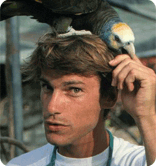Cockatoo Companion?

I have a 2 year old Lesser Sulphur Crested Cockatoo hen, Perdy . She lives in 35 meter aviary with 15 mixed species or in the house with 2 pet Greys. I think she needs a companion. Should I look for a male or a female given that her species in CITES1 in the wild. Dorothy Schwarz

It really sounds like your bird has a LOT of potential companions already, but back to that in a minute. I suspect what you’re really wondering is whether there is a sound conservation justification for breeding your female cockatoo because this species is quite rare in the wild (recall that CITES status isn’t specifically about rareness, rather the potential or real threat from trade). Given your bird’s history of being around other parrots in the west, it would be very difficult for your bird to be paired for conservation breeding strictly from a disease standpoint. Even if your birds are extraordinarily healthy, they clearly have had opportunities to pick up all sorts of things from all over the world - directly or indirectly - and many of these diseases can be hard to detect. As there are some islands in Indonesia with reasonable numbers of these birds, it is unlikely that captive pet birds like yours or their progeny will play a direct role in the recovery of the species in the wild. Clearly, there are a few species of parrots for which every individual is of potential conservation significance, but these are tremendously rare species like Kakapo, Spix’s Macaws, and the like.
But that of course does not mean that your bird(s) can’t have huge conservation significance in terms or raising awareness and support for the conservation of their brethren in the wild. Your birds are great ambassadors for their species and for parrots in general. Because they are such engaging and spectacular animals, captive parrots create great opportunities to educate and inspire individuals to help conservation all over the world. Many of the most consistent and generous supporters of parrot conservation have been inspired by a relationship or experience with a single bird and yours may well have the same great influence on people.
In terms of companionship, it’s very hard to guess what would be best for your bird without experiencing the individual(s) in question and watching very carefully. My colleagues and I go back and forth on the question of the specific benefits of companionship with a bird’s own species vs. other species. Part of the reason for this must be that species and individuals vary a great deal, and some treat birds of their own or other species like potted plants, while others would happily move in with the neighbor’s cat (I’ve had both extremes in my time). If your cockatoo really doesn’t get much out of your other birds, you might ask around local rescue centers to see if there is a cockatoo you might introduce her to to see how they get on. But as a cockatoo owner, I’m sure you’re aware that there are big and sometimes dangerous gender differences, so be careful, talk to other’s knowledgeable about this, and tread cautiously. And of course, practice very careful biosecurity whenever introducing your birds to others or others to your flock.
All best wishes,
Jamie

































